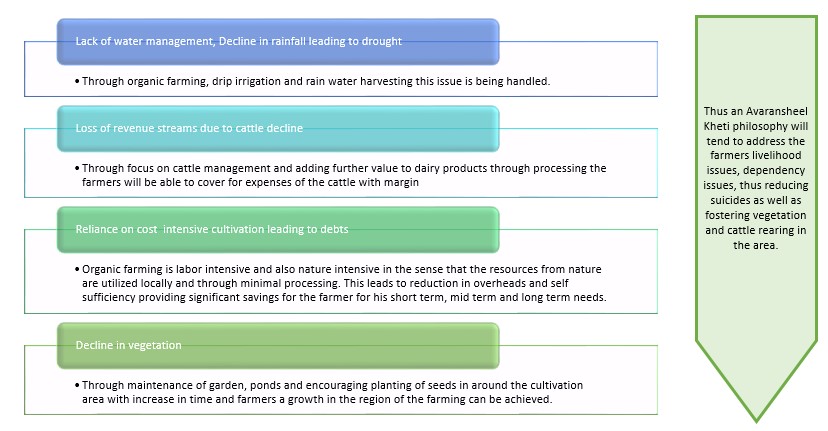Bundelkhand Incubator Initiative
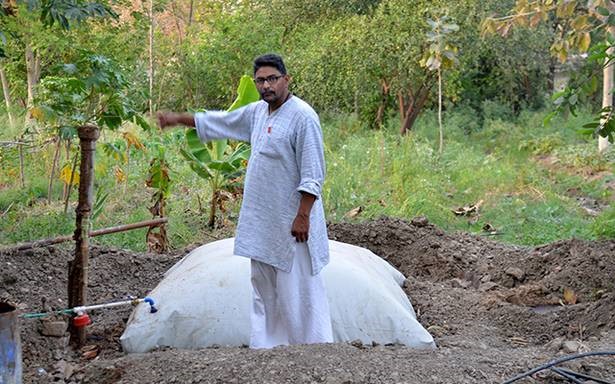
To provide guidance through farmers’ training school and financial support through an incubator fund to farmers of the region to enable them to transition to Avartansheel kheti (a sustainable, organic farming practice) that will ,
- 1) Make agriculture profitable and sustainable, thus reducing farmer stress and suicides.
- 2) Address the stray-cattle problem.
- 3) Improve ground water levels.
- 4) Counter deforestation.
Drought:
Surveys have shown that the districts namely Datia, Tikamgarh, Jhansi, Mahoba and Hamirpur districts were facing severe drought vulnerability followed by Lalitpur, Jalaun and Banda.
Deforestation:
There is a steep decline in vegetation from the year 1998 to 2009 resulting in the conversion of the region from an arid vegetation in few locations to sparse and arid vegetation with the rocky terrain dominating the region.
Stray Cattle:
Stray cattle are everywhere in drought-hit Bundelkhand—roaming the highways at night, foraging in barren fields where no crops have grown in the past year, even just lying down and dying on bone-dry lake beds. Social activist Yogendra Yadav of NGO Swaraj Abhiyan, alleged that three lakh cattle had died in the drought-hit region in the month of May 2016 alone.
Mining and Quarrying:
The value of granite found in UP Bundelkhand districts alone is around Rs 60,000 crore according to UP Directorate of Geology estimates. In Bundelkhand, the sand and stone mining is a Rs 900 crore industry.
Crop fields have been declared as ‘barren land’ and quarrying industry has been set up on farm land. The mining mafias including political leaders in collusion with local administration and pollution control board have got agricultural land declared as ‘barren’ land.
Farmer Migration, Debt and Suicides:
In years of crop failure, villages that have a population composed entirely of SC or ST marginal farmers and landless labourers become deserted. In 2007, 33 of the 200 villages in the Naraini block of Banda district were deserted. In times of crop failure, the proportion of migrants shoots up to over 50% of the working population of many villages.
The total amount of current outstanding rural bank debts in Bundelkhand is Rs 4,370.32 crore. This is 21% more than 2010 when the total bank debts stood at Rs 3,613.22 crore.
In the year 2009, 568 farmers and in 2010, 583 farmers have committed suicide due to various reasons in Bundelkhand as per official records. In the seven parched districts of Bundelkhand that fall in Uttar Pradesh at least 3,000 farmers killed themselves over the last five years, according to official records and suicides reported in newspapers from 2009-14.
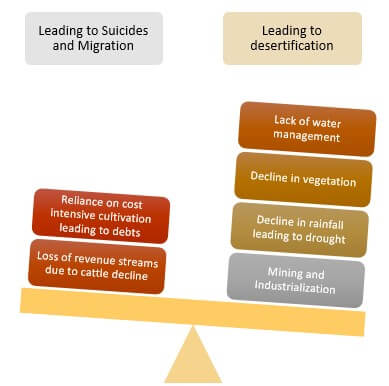

Prem Singh a farmer hailing from Bhurokhar Khurd village, has been practicing a sustainable farming model called Avatansheel Kheti, a transformation he felt necessary after he ended up in debt and became entirely depenent on seed and fertilizer suppliers, subsidized bank loans and mandi agents.
Change and Method of Approach
Prem Singh understood through his situation that a decisive change in his method was required. This led to him of developing an approach called Aavartansheel Kheti which roughly translates as periodic proportionate farming. He has perfected this approach by iterating it over a period of 20 years.
He understood that the required resources already existed in the nature and set the following principles to transform to his new approach:
- • Self-sufficiency and erasing dependency
- • Seeds and Fertilizers: For this purpose he understood that he had to procure seeds which will be lacking chemicals and thus will cost low and procure them from organic sources. And eventually produce his own seeds. He shifted to natural fertilizers.
- • Power, Irrigation and Resources: He understood the water needs of his crops and adopted water management techniques. For erasing the dependency on the power he switched his entire farm to solar power. He also started using resources to reduce his ancillary expenses such as biogas.
- • Mandi Agents: He understood that there is a huge difference in the price of processed and non processed product and that on a small scale processing can be done by the farmer himself along with ancillary support in form of manpower and low cost machines. He also established his own brand for the sale of these products knows GAON which means village.
- • Organic farming through natural resources- He realized that organic farming is the need of the hour for the farmers as well as for the end consumers. Organic farming he found is sustainable in the long term and encourages self sufficiency and harmony with nature.
- • Maintaining balance with nature- Nature for Prem Singh became an avenue from where he can draw resources, livelihood and tranquility by following a few labor intensive but simple rules. He understood to continue his farming he has to follow these rules and at the same time to develop a sanctuary in his farmland where nature can thrive.
Result and Current Status
- • The ecosystem includes everything. From producing his own manure, seeds and medicine to a mango tree garden, a pond, sufficient grazing land for the cattle and a cow guest house, a farmers museum and a Kisan school where he encourages and guides other farmers on their own transformation process.
- • The farm is fully powered by solar and only a small power tiller is needed to plough the farmland. And to close the circle to the end consumer he runs his own processing unit where the outcome of his farm (and this from other farmers) turn into meanwhile 30 different products. They all sell under the brand "GAON".
- • This model of farming creates a balance and addresses the problem of depleting ground water, tree cover, stray cattle management while providing a sustainable and profitable mode of doing agriculture hence reducing suicides and migration.
The brand under which Prem Singh’s farm produce is sold.
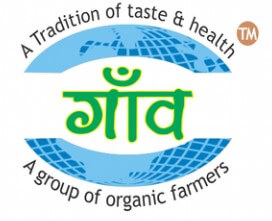
It currently has an annual turnover of upwards of 40 lakh.
Steps and Approach
- Step 1: Connecting and identifying the farmers Awareness of the program and the existing support facilities will be informed to the farmers in the adjoining areas requiring a platform to transform their agricultural practices and their livelihood sustenance.
- Step 2: Training and Design- The farmers will be trained at Prem Singh’s incubator and will be provided with knowledge and support to develop designs for organic, self-sufficient farming practices in their land holdings.
- Step 3: Supervision & Transformation- The farmer’s transformation to organic farming will be supervised by the incubator’s employees and Prem Singh which will be evaluated periodically and they will be provided with advice in the areas they are lacking.
- Step 4: Sale and Procurement sufficiency- The farmers will be provided with a sale outlet for their produce as well as support in seeds for growing their produce through the GAON brand and the incubator. Through the farmer will be eventually made self-sufficient wherein his dependency will be completely eliminated and his produce is more in demand due to its quality.
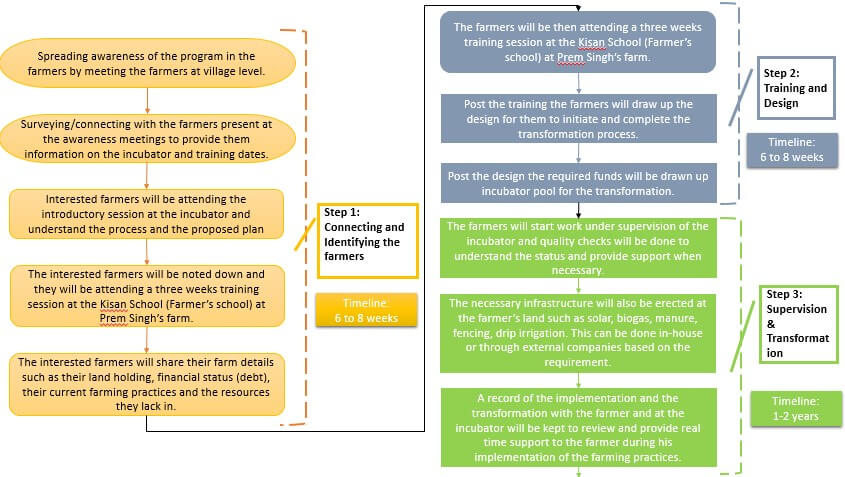
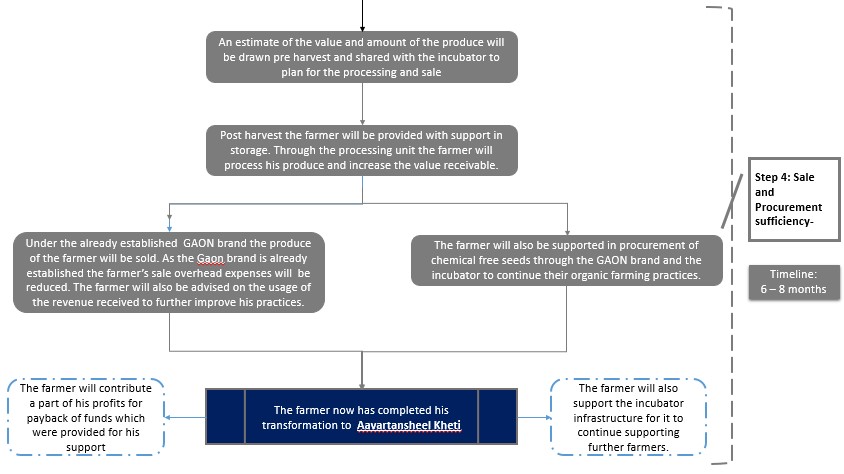
To provide guidance through farmers’ training school and financial support through an incubator fund to farmers of the region to enable them to transition to Avartansheel kheti (a sustainable, organic farming practice) that will , 1) Make agriculture profitable and sustainable, thus reducing farmer stress and suicides. , 2) Address the stray-cattle problem. ,3) Improve ground water levels. , 4) Counter deforestation.
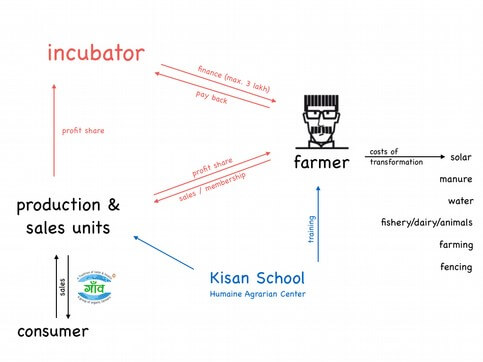
Aavartansheel Kheti & its benefits
The goal of the incubator is to give financial help to farmers who are ready to change their way of farming to Aavartansheel Kheti. The plan is to fund over 5 years 500 farmers with a maximum of Rs. 3,00.000 per farmer at 0% interest rate. The incubator will help the farmers in the following:
- • To attend a Aavartansheel Kheti management course at the Kisan School
- • To deliver the harvest and/or processed products to a GAON processing and sales unit
- • To pay back the "loan" after 5 years in max. 5 installments
- • Significantly reduce the poverty among farmers
- • Improve the infrastructure in rural areas and therefore up-lift rural life style make the farmers self-sufficient
- • Create a new breed of entrepreneurs
- • Reduce the need for government subsidies
- • Contribute to a better balance of nature, animal and humans on our planet
- • Contribute its fair share to fight the climate chaos
Training Process
A Kisan School is already established at Prem Singh's farm. All incubates need to attend a three week course before they start the transformation process. It's mandatory. It will help them to understand and develop the aspects of Avaransheel Kheti for their own farm.
The three week course is split into three parts.
- • Theory- Week 1
- • Turning theory into action- Week 2
- • Designing the model farm- Week 3
Processing Units & GAON Brand
- • In 1995 Prem Singh started his own processing unit. Today Singh manufactures 30 products under his own brand GAON. GAON means village. Already 100 farmers bring their harvest to his factory where they receive 20-25% more money than the conventional market offers them.
- • The manufacturing process is unique in the country. They clean, separate and roast the natural material. This makes the process cost intensive – therefore the products sell up to 30% more than competitive products which aren't processed this way. But customers are ready to pay – they say they taste the difference.
- • The difference is in the organic quality of the product and in the way it is processed. It will be mandatory for the farmers who receive funds from the incubator to contribute to the GAON processing unit(s). The incubates should be capable of contributing to the processing units three years after they've started their transformation process.
- • The idea is that a certain percentage of the future GAON profits will be distributed to the farmers (shares) and another percentage will be going to the incubator to help supporting more farmers in their transformation process. Our estimate is when 500 farmers have become self-sufficient and contribute to GAON that the GAON shares will fund an additional 10 farmers per year.
Budget and Action Plan
By setting up the action plan we have worked on a budget for the additional infrastructure and services along with the basic support required to help transform the farmer’s livelihood:
- • Funds to provide necessary support infrastructure to farmers
- • Funds for increasing processing units:
- • Processing unit for grain and fruit
- • Processing unit for milk
- • Processing unit for flax
- • Funds for administrative expenses for the Kisan School, GAON brand and the processing units.
Action plan will consist of:
- Forming a regulatory structure for the incubator, Kisan school and the GAON brand
- Forming a feedback structure for the incubates
- Forming a transparent free flow financial structure for the farmers to collect their revenues and the infrastructure to work efficiently
Financials and Numbers
The numbers can be referred from the attached link of excel
The funds will be raised by connecting and sharing the idea with the following entities:
- • Private organizations and investors
- • Government subsidiaries
- • GAON processing units
- • NABARD Bank
